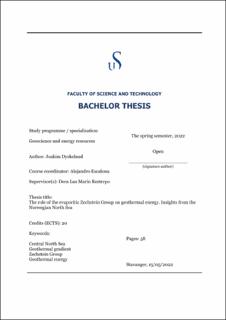| dc.description.abstract | Geothermal energy could potentially contribute to reduce CO2 emissions at Norwegian Continental Shelf if it is used for electrification of platforms. The main focus for this thesis is to improve the understanding of the mechanisms affecting the geothermal gradient in the SW part of the Norwegian North Sea, and to propose a preliminary geothermal energy play concept in the study area. The study area is located in the Feda Graben, approximately 310 km south-west of Stavanger in the Central Graben. 3D seismic and well data will be utilized to study and propose a geothermal play, as well as the influence of the evaporitic Zechstein Group on the geothermal gradient.
For this study, the geothermal heat is divided into three different levels of temperatures: 90˚C, 120˚C and >150˚C. As the generation of electrical power requires quite high temperatures, the main focus will be temperatures equal or higher than 120˚C. Fluid can be used with direct use for temperatures between 90˚C to 120˚C, while temperatures larger than 150˚C is high enough for power generation. To define a geothermal play concept the following elements were considered: 1) the reservoir rock quality (both porosity and permeability); 2) the presence of fluids; 3) a heat source; 4) a seal and 5) a trap. In addition to this, mechanisms interpreted to affect the geothermal gradient are: the evaporitic Zechstein salt and a shallow Moho. Both having an important role leading to high geothermal temperatures in the study area.
Based on the temperatures (higher than 120 °C) the following groups and formations are suggested as potential reservoirs in the study area: the Hordaland Group, consisting of a sandstone layer at the base, the Shetland Group, consisting of chalk and the Haugesund Formation, consisting of sandstone. Some of the wells in the study are drilled on or close to the salt diapirs, where the groups are getting very thin. The lithologies consist of mostly sandstone, shale, and chalk, where shale is working as an impermeable cover, sealing the geothermal reservoir. The sandstone and chalk are good potential reservoirs, being able to contain fluids, heated by the interplay between a shallow Moho and shallow salt diapirs in the Norwegian North Sea. Further, a Binary Power plant would be best possible suggestion to extract the geothermal energy.
A model of the geothermal play concept has been proposed based on the elements required for a good geothermal reservoir. The traps identified consist of stratigraphic pinch-outs, and the potential reservoirs are displayed close to the salt diapir. | |
